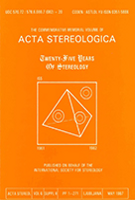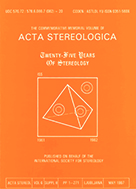- Accueil
- Volume 12 (1993)
- Number 2 - Proceedings of the sixth European congr...
- Reversed stereology and its application to interaction between second phase and grain boundary
Visualisation(s): 251 (1 ULiège)
Téléchargement(s): 18 (1 ULiège)
Reversed stereology and its application to interaction between second phase and grain boundary

Abstract
‘Reversed stereology’ is a set of methods for quantitative characterization of feature/feature interaction(s) by applying the fundamental stereological principles in reverse order. Its basic idea is as follows:
Let Yi and Yj represent two sets of geometric features (e.g. points, lines, surfaces, volumes) embedded in a three—dimensional structure, X3,Tj be a set of isotropic uniform random test probes superimposed artificially onto the structure, where i and j denote the dimensionality of the corresponding features or probes. If the intersection sets Yi⋂Yj and Yi⋂Tj are not empty, then the parameters Q(Yi⋂Yj) and Q(Yi⋂Tj), where Q = surface area, line length, number of points or number of features, etc., can be combined into various estimators of the degree of randomness of the interaction between Yi and Yj.
Examples of application of reversed stereology to the quantitative characterization of interaction phenomena between geometric features related to second phase and grain faces, edges, and corners are systematically discussed in this paper.





